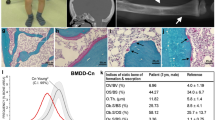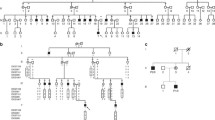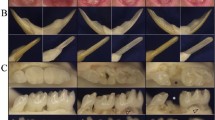Abstract
The mouse mutation fragilitas ossium (fro) leads to a syndrome of severe osteogenesis and dentinogenesis imperfecta with no detectable collagen defect. Positional cloning of the locus identified a deletion in the gene encoding neutral sphingomyelin phosphodiesterase 3 (Smpd3) that led to complete loss of enzymatic activity. Our knowledge of SMPD3 function is consistent with the pathology observed in mutant mice and provides new insight into human pathologies.


Similar content being viewed by others
Accession codes
References
Forlino, A. & Marini, J.C. Mol. Genet. Metab. 71, 225–232 (2000).
Sillence, D.O., Senn, A. & Danks, D.M. J. Med. Genet. 16, 101–116 (1979).
Glorieux, F.H. et al. J. Bone Miner. Res. 15, 1650–1658 (2000).
Glorieux, F.H. et al. J. Bone Miner. Res. 17, 30–38 (2002).
Ward, L.M. et al. Bone 31, 12–18 (2002).
Guénet, J.-L., Stanescu, R., Maroteaux, P. & Stanescu, V. J. Hered. 72, 440–441 (1981).
Muriel, M.P. et al. Bone 12, 241–248 (1991).
Sillence, D.O., Ritchie, H.E., Dibbayawan, T., Eteson, D. & Brown, K. Am. J. Med. Genet. 45, 276–283 (1993).
Goni, F.M. & Alonso, A. FEBS Lett. 531, 38–46 (2002).
Grey, A. et al. Calcif. Tissue Int. 74, 542–550 (2004).
Takeda, H. et al. FEBS Lett. 422, 255–258 (1998).
Wu, L.N., Genge, B.R., Kang, M.W., Arsenault, A.L. & Wuthier, R.E. J. Biol. Chem. 277, 5126–5133 (2002).
Goldberg, M. & Boskey, A.L. Prog. Histochem. Cytochem. 31, 1–187 (1996).
Auge, N. et al. J. Biol. Chem. 273, 12893–12900 (1998).
Acknowledgements
We thank G. Langsley and K. McElreavey for critical reading of the manuscript and C. Kress for cell culture support. This work was partly supported by a Seed Grant from the Osteogenesis Imperfecta Foundation to C.P. and by a Fellowship from the CANAM to I.A. This paper is dedicated to the memory of Ritta Stanescu who, in collaboration with her husband Victor Stanescu, made many careful analyses aimed at a better understanding of the physiopathology of this mutation.
Author information
Authors and Affiliations
Corresponding author
Ethics declarations
Competing interests
The authors declare no competing financial interests.
Supplementary information
Supplementary Fig. 1
Sequences of the Smpd3 gene in the vicinity of the deletion breakpoint. (PDF 1035 kb)
Supplementary Fig. 2
Protein models of Smpd3 normal and mutant forms. (PDF 1020 kb)
Supplementary Table 1
Sequences of the primers that have been used for RT-PCR assays. (PDF 358 kb)
Rights and permissions
About this article
Cite this article
Aubin, I., Adams, C., Opsahl, S. et al. A deletion in the gene encoding sphingomyelin phosphodiesterase 3 (Smpd3) results in osteogenesis and dentinogenesis imperfecta in the mouse. Nat Genet 37, 803–805 (2005). https://doi.org/10.1038/ng1603
Received:
Accepted:
Published:
Issue Date:
DOI: https://doi.org/10.1038/ng1603
- Springer Nature America, Inc.
This article is cited by
-
Neutral Sphingomyelinase 2 Mediates Oxidative Stress Effects on Astrocyte Senescence and Synaptic Plasticity Transcripts
Molecular Neurobiology (2022)
-
Metabolomic biomarkers of low BMD: a systematic review
Osteoporosis International (2021)
-
Effects of lipid metabolism on mouse incisor dentinogenesis
Scientific Reports (2020)
-
The Role of Vesicle Trafficking and Release in Oligodendrocyte Biology
Neurochemical Research (2020)
-
Deficiency of sphingomyelin synthase 1 but not sphingomyelin synthase 2 reduces bone formation due to impaired osteoblast differentiation
Molecular Medicine (2019)





